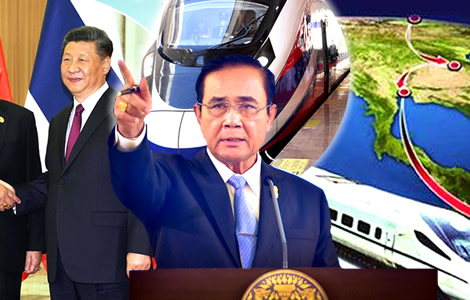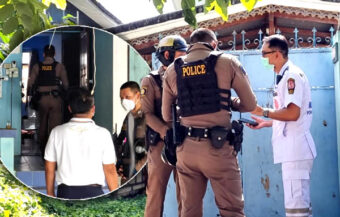The high-speed rail link for which a contract was signed between the State Railway of Thailand and four Chinese firms on March 29th 2021 is understood to be proceeding at a slow pace with only 4% of the project as yet complete extending from Nakhon Ratchasima. There had been uncertainty about the second phase of the proposed high-speed rail link being pushed by China linking Nakhon Ratchasima with Nong Khai although Thai planners are now reported to have prepared their own blueprint. In December, Thai Minister of Transport, Saksayam Chidchob reaffirmed Thailand’s commitment to the Thai Chinese high-speed rail link and promised that the second line, linking Bangkok with Nong Khai by hi-speed rail, would be operational by 2028. Thailand already operates an existing rail service to Nong Khai which is linked to Bangkok.
After years of rhetoric, negotiations and the signing of accords, the Chinese Belt and Road initiative came knocking on Thailand’s door last December with the opening of the Boten to Vientiane high-speed rail link which has suddenly opened up northern Thailand to China’s southern provinces. While Thai authorities are working to embrace the opportunity the initiative has to offer, there are already signs that the reality on the ground will, at the same time, present challenges for Thailand.

China’s Belt and Road initiative came to life in northeastern Thailand last December when the rail link from Boten in Laos near its border with Yunnan in China and the capital Vientiane was inaugurated on the 3rd December 2021.
The electrified rail system, in standard gauge, spans 422 km and is operated as a joint venture between Laos and China. The project took nearly 5 years to complete at a cost of $6 billion.
The huge rail project has contributed significantly to the debt crisis in Laos which is facing $13.3 billion in debt, an impossible burden for a small underdeveloped nation. The government there is counting on the rail link to become profitable by 2027 but this cannot happen without the development and extension of the line by Thailand.
Laos is facing a debt crisis pushed by China’s vision
A withering analysis by Jonathan Lane of the Asian Development Bank Institute in December did not pull punches. He said that there was ‘limited commercial logic for an expensive railway’ in Laos given its tiny, insubstantial market.
He warned that the small nation was squarely facing a debt crisis caused by the rail project and others like it pushed with finance provided via Beijing as part of its Belt and Road vision. ‘That debt service will put further strain on the limited tax-raising abilities of the government,’ he stated baldly in a report.
Large rice shipment watched closely last week
In the last week, the eventual delivery of a large shipment of rice to the southwestern Chinese city of Chongqing was supposed to represent the progress being made in cooperation between China and Thailand to boost trade not only with the launch of the huge Regional Comprehensive Economic Partnership (RCEP) free trade pact on January 1st but the opening of the new high-speed rail link from China into Laos.
The new high-speed rail link is connected, through Vientiane, with Thailand’s border at Nong Khai.
Impact of the new rail link appears to be decidedly mixed since December for Thai exporters and farmers
Since its opening in December, however, the consequences of the new connection have been decidedly mixed with reports of difficulties being experienced by Thai exporters at the Chinese border while since December, Thailand’s northern provinces have reportedly been inundated with cheaper agricultural produce from southern China.
This has led to a flurry of cooperation between the Ministries of Commerce and Agriculture in Bangkok with plans to boost Thai exports to China from March or the beginning of the harvest season while strengthening logistical capability in northeastern Thailand to take advantage of the new rail link to China.
Earlier in January, Thai exporters complained vociferously at the inability to ship product into China through the new rail connection while farmers across the North of Thailand were drawing attention to the influx of cheap vegetables and other produce that appeared suddenly in December in the kingdom’s northern provinces as a result of the new line.
Rice shipment initially held up by Chinese customs
The large shipment of glutinous rice from Thailand weighing 500 tons was reportedly exported to Chongqing, a huge metropolis in Southwestern China, on January 20th at the border point between Laos and Thailand at Nong Khai but was held up due to customs issues at the Chinese border.
The situation echoed ongoing reports of problems being experienced among Thai fruit exporters in dispatching goods to Southern China. The same concerns emerged among exporters from other countries, notably Vietnam, in recent weeks.
In mid-January, the Thai Minister of Commerce Jurin Laksanawisit whose ministry is responsible for exports and who was a key architect of the ground-breaking Regional Comprehensive Economic Partnership (RCEP), the huge free trade pact between ASEAN and 5 other countries in the Asia Pacific including China which came into effect for both China and Thailand on the 1st January 2022, told reporters that the new high-speed rail link through Laos, built and financed by China, was limited at present, to ores, rubber and cassava and excluded fruit exports from Thailand for now.
Cargo was eventually delivered 3 days later but only after official representations were made by Thailand
On January 22nd, Mr Alongkorn Pholbutr, a key official with the Ministry of Agriculture told reporters that the large consignment, sent originally on January 20th, dispatched by Thai firm Klathip Co. Ltd in Nong Bua Lamphu to the huge Chinese city, would be sent on Wednesday, January 26th via the Mohan Railway in southern Yunnan Province to Chongqing in southwestern China.
The official outlined, at length, the negotiations and ongoing contacts involved in ensuring the delivery of the cargo including talks with the Lao Ambassador to Thailand.
Later reports from Laos suggest that the cargo was, in fact, delivered on Sunday the 23rd of January, to Chongqing.
The confusion surrounding the shipment comes as Thailand appears to be grasping the significance of the new rail connection running through Laos which offers faster access to the Chinese market.
Bangkok orders more rail connections and a second bridge into Laos at Nong Khai to boost border trade
Bangkok has recently ordered the State Railway of Thailand to build a second bridge over the Mekong River in Nong Khai to facilitate more trains and traffic from northeastern Thailand along with upgrading the kingdom’s existing rail network with a train connection planned linking Nong Khai with Laos and the new hi-speed station adjacent to Vientiane.
Thailand opened a rail link into Laos in 2009 to Thanaleng Railway Station.
In September 2021, the State Railway of Thailand announced plans to upgrade its facilities in Nong Khai to cater for more freight traffic on the route into Laos and a connection with the new hi-speed rail link from China.
It is also understood that efforts are being made by the Laotian rail authorities to link the station at Thanaleng with the high-speed train depot near Vientiane.
Pushing a Bangkok to Nong Khai hi-speed rail link
In December, the Minister of Transport Saksayam Chidchob, as well as renewing Thailand’s commitment to the high-speed rail link to Nong Khai, also came forward with plans to rapidly increase infrastructural development and logistics facilities in the strategically important Thai city of Udon Thani to create what Thai planners see as a new transport hub.
The minister said that the first hi-speed train linking Bangkok with Nong Khai would be ready to travel in 2028.
A later decision to give the green light to the new bridge and increased rail capability was only taken on January 13th by the cabinet in Bangkok.
Rail link to China is now far cheaper and significantly faster than normal freight or shipping
The new rail connection through Laos will make it possible for produce and goods to reach southern Chinese cities within 48 hours from northern Thailand or at the outside, between 3 to 4 days which is at least four times faster than sea freight.
The new rail connection was inaugurated in Vientiane, Laos, on December 3rd last and has quickly allowed rapid and convenient access to Chinese imports destined for Thailand while Thai exporters have been slower to use the new service.
There has not been a long history of rail freight in Thailand which currently accounts for only 2% of the country’s internal freight and logistical capability.
Significant step for Beijing’s Belt and Road initiative
The opening of the China Laos railway in early December represents another step forward for China’s ambitious Belt and Road initiative which has run into some difficulty with Thai planners and analysts who increasingly see a downside to the scheme which has seen very slow progress on plans to construct a Chinese designed hi-speed rail link connecting Bangkok ultimately with Nong Khai.
Advocates for the Chinese inspired project point to the increased costs in recent months of shipping and freight costs for Thailand’s exports to the United States and Europe while highlighting that the new rail connection can also possibly allow Thai exports to reach the European continent by traversing the routes being planned for China’s expanded Belt and Road vision.
Some reports suggest that shipping costs have risen by between 200% and 1000% in recent weeks as the world’s economy began to crank up with a receding pandemic, at least outside the Chinese mainland.
Beijing’s vision is an Indochina rail system from China to Singapore through Thailand and Malaysia
The Chinese plan is to have a high-speed rail link, designed to its own international standard, connecting Chinese cities in the southern region of the communist country which has been earmarked for rapid economic growth with Singapore via Thailand and Malaysia.
Economic analysts have been lining up to praise the initiative such as Surasit Thanadtang who is the Director of the Thai-Chinese Strategic Research Centre at the National Research Council of Thailand.
‘This model can build an integrated logistics system of the China-Indochina Peninsula Economic Corridor,’ said Mr Surasit, a view which supports the expansive ambitions of China’s Belt and Road initiative which the United States is increasingly warning Southeast Asian countries to be wary of.
Threat to Thailand from the encroaching dragon of the North as Chinese factories in Myanmar burn
Thailand’s PM commits to a global world vision as the country signs up to China’s belt and road
China and Thailand forging deeper ties which may pose a problem for western firms in the future
The attraction for Thai exporters of opening up faster and cheaper freight routes with its second-largest export market is clear.
Thammasat professor sees the opportunities for Thailand but danger too in trade with a ‘savvy’ China
Mr Pavida Pananond is a Professor of International Business at the kingdom’s prestigious Thammasat University.
He sees the new rail route as an opportunity to be explored and exploited but also warns it is a double-edged sword even in terms of trade.
He acknowledges that this is undoubtedly a gateway for Thailand into Chinese markets from Thailand’s underdeveloped northeastern region which could be particularly valuable for the country’s important fruit farming sector.
However, he is also warning that the Thai government must be ‘savvy’ in their dealings with China which is increasingly being seen internationally as deploying clandestine or less than scrupulous tactics or as Professor Pavida put it: ‘not-so-transparent practices’.
Thailand warier than Laos of China’s high-speed rail ambitions from the get-go but signed a deal in 2021
The Thai government, in its talks and engagement with China and indeed Japan over the last two decades on the proposed internal hi-speed rail connection, significantly raised the question of the kingdom’s sovereignty and ability to control the operation of the rail network.
It ruled out a similar arrangement to that agreed by the government in Laos with China for the just-opened Boten to Vientiane high-speed rail link.
This led to several redesigns and reorganisations of the project for a Thai Chinese high-speed rail link before a deal was signed in March 2021 between a Chinese construction consortium and the government to build the first leg of the proposed connection between Bangkok and Nakhon Ratchasima.
Significantly, the project is to be financed by Thailand and to be operated by the kingdom although it will conform to Chinese technical standards and use Chinese technology.
Northern traders began asking questions late last year
Questions began to be asked about the new rail link with China late last year when traders in Thailand began to raise concerns about problems created by imported goods, in particular, food and fruit from China as well as an inability to export products into China through Laos by road even before the rail link opened.
One Thai agency, the Provincial Office of Agricultural Research and Development, linked with the Ministry of Agriculture, revealed a 93.33% falloff in longan fruit exports from Thailand to China for one region in the kingdom from 2020 to 2021 because of new import restrictions in China imposed at the border and linked with the COVID-19 emergency.
This led to a sharp fall in the price being obtained by growers of the fruit from up to ฿35 per kilo down to ฿10 per kilo.
Lower prices have also been reported in northern Thailand for vegetables such as cabbage and tomatoes since the operation of the rail link between China and Laos commenced, flooding Thailand with cheaper produce from Southern China.
Prices of both vegetables more than halved as a consequence severely impacting already struggling Thai farmers and making markets less predictable
Officials called upon to coordinate reciprocal entry arrangements for Thai produce and exports to China
This has led Thai industry leaders to urge Bangkok officials to liaise with their Chinese counterparts to smooth the way for a full and genuine two-way trade with China concerning the faster rail service.
In the meantime, the government in Bangkok has highlighted the expansion of the train service between Thailand and China and has ordered an increase in rail services to Nong Khai from four trains per day to 14 carrying 25 carriages instead of 15 previously.
Nevertheless, farmers and producers in Thailand remain apprehensive.
In December, the Chairman of the National Farmers Council, Prapat Panyachatraksa warned of goods from China ‘flooding in’ to the market in Thailand while Beijing continued to block Thai produce going in the other direction.
Bangkok plans to push Thai exports from March
The Thai government led by key officials at the Ministry of Agriculture and Ministry of Commerce are meanwhile understood to be focused on opening up the new faster route into China for Thai produce from March this year in time for Thailand’s harvest season in a concerted effort to grasp the opportunity for the kingdom to boost its exports.
Thailand’s plan, for now, is focused on maximising the opportunity by enhancing the kingdom’s existing rail network while also increasing logistical support and capacity into Laos to push Thai exports into China.
It will be at least 2026 before even the first leg of the more ambitious plan for a high-speed rail link from Bangkok to the northeastern city of Nakhon Ratchasima is complete while some analysts question the need for a high-speed passenger network from Nakhon Ratchasima to Nong Khai.
Current project, signed in March 2021, for a passenger high-speed rail link between Bangkok and Nakhon Ratchasima will not be ready until 2026 at the earliest
The scaled-down project for a hi-speed rail link between Bangkok and Nakhon Ratchasima for which a contract was signed in March 2021 only encompasses a high-speed rail link for passenger traffic with a maximum speed of 250km per hour.
The current project which is underway but proceeding very slowly is projected to cost $5 billion or ฿170 billion and came about after Thailand pulled out of a proposed joint venture with China.
The deal was signed between the State Railway of Thailand and the China State Construction Engineering Corporation together with four other companies on March 29th 2021 in a ceremony overseen by Minister of Transport Saksayam Chidchob.
Thailand is funding the scaled-down project and will operate the service while the design and rail technology for the service will be provided by the Chinese construction consortium.
Currently, it is understood that only 4% of the work on the project has been completed with an extension of a 3.5 km rail track from Nakhon Ratchasima.
Despite enthusiastic rhetoric from government officials, there are doubts about completing the project even by 2026. There are also reports of friction and tensions between Chinese and Thai personnel working on the scheme.
Design prepared for the second stage still shrouded in uncertainty with doubts about what is required
There is even further uncertainty about the second stage of the plan, a high-speed link from Nakhon Ratchasima to Nong Khai despite the minister’s commitment in December and reports that Thailand has already prepared its plans for the rail link completed by its own professionals.
This second stage is crucial to completing China’s Belt Road ambitions to link southern China with Singapore by hi-speed rail.
Thailand, of course, already operates a rail link between Bangkok and Nong Khai.
The kingdom’s goal for the project may diverge from its more powerful northern neighbour as Bangkok’s sights are firmly fixed on the narrow objective of boosting trade and exports into Laos and onto Southern China, one that has so far been frustrated by conditions on the ground.
World’s growing unease at Chinese expansionism
The lack of progress on the rail project and partnership with China reflects growing unease in Bangkok about Chinese expansionism even within the economic sphere with the kingdom being pulled between competing financial and commercial interests from the United States and Thailand’s biggest investor, Japan.
This comes with growing tensions in the Asia Pacific between China and the United States which increasingly bears the hallmarks of a cold war with Beijing’s rhetoric and actions becoming increasingly belligerent particularly in relation to Taiwan.
Join the Thai News forum, follow Thai Examiner on Facebook here
Receive all our stories as they come out on Telegram here
Follow Thai Examiner here
Further reading:
Ministry fails to halt ฿25.4 billion payment order to Hong Kong based firm linked to 1990 contract
Drinks giant Thai Beverage to resume expansion with Singapore IPO for Asean regional beer operation
China and Thailand forging deeper ties which may pose a problem for western firms in the future
Chinese FM to visit Thailand in a Covid battered world of raised tensions and potential conflict
Prime Minister indicates that the cabinet reshuffle will be complete very shortly with no problem
Thailand’s economy has become dependent on government expenditure to stay above water
Thailand and US aim for a new more ‘proactive’ trading relationship as ambassador meets Prayuth
Rice price spike but drought conditions to recede – security concern for the Mekong river
US suspension of Thai preferential trade partner status part of Trump’s ongoing trade war


















